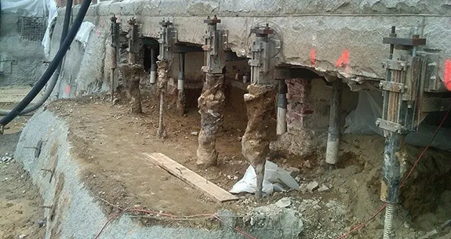Foundation underpinning is important to strengthen the foundation of buildings. It involves strengthening and stabilizing the existing foundation to ensure the structure’s safety, serviceability, and durability. Whether you’re dealing with an old building showing signs of distress or planning to add extra floors, underpinning can provide the necessary support.
What is Foundation Underpinning?
Underpinning is the process of reinforcing an existing foundation by extending it in depth or breadth. This is done to transfer the building’s load to more stable soil or bedrock, thereby improving the foundation’s load-bearing capacity and stability.
When is Underpinning Needed?
Underpinning is typically required in the following scenarios:
- Foundation Failure: When the existing foundation shows signs of distress such as cracks, uneven floors, or sinking.
- Additional Loads: When planning to add extra floors or heavy equipment that the current foundation cannot support.
- Soil Movement: When the soil beneath the foundation has shifted due to natural causes like earthquakes or human activities.
Types of Underpinning Methods
- Mass Concrete Underpinning: This traditional method involves excavating sections below the foundation and filling them with concrete. It’s simple but labor-intensive.
- Beam and Base Underpinning: This method uses beams to transfer the load to mass concrete bases. It’s suitable for deeper foundations.
- Mini-Piled Underpinning: Ideal for sites with restricted access or where the soil conditions are variable. It involves driving small piles into the ground to support the foundation.
- Screw Piles and Brackets: This modern method uses screw piles and brackets to support the foundation. It’s quick and causes minimal disruption.
Pros and Cons of Foundation Underpinning
Pros:
Increased Stability: Enhances the load-bearing capacity of the foundation.
Versatility: Can be used for various types of buildings and soil conditions.
Longevity: Extends the life of the building by preventing further settlement and damage.
Cons:
Cost: Can be expensive, depending on the method and extent of work required.
Disruption: May cause temporary disruption to the building’s occupants.
Complexity: Requires skilled labor and careful planning.
Step-by-Step Underpinning Procedure
Assessment: Conduct a thorough assessment of the existing foundation and soil conditions.
Design: Develop a detailed underpinning plan, including the method and materials to be used.
Excavation: Carefully excavate sections below the foundation.
Installation: Install the underpinning elements, such as concrete, piles, or beams.
Backfilling: Fill the excavated areas with suitable material and compact it.
Conclusion
Foundation underpinning is a vital process for maintaining the structural integrity of buildings. By understanding the different methods and their applications, you can ensure that your building remains safe and stable for years to come. Whether you’re dealing with foundation failure or planning an expansion, underpinning provides a reliable solution to strengthen your building’s backbone.
External Resources-
A Detailed Guide to Underpinning of Foundations
Read Also-
What is Timbering? – Importance and Methods of Timbering
Foundation on Black Cotton Soil – Problems and Solutions
What is Soil Liquefaction? (Process, Causes, and Mitigation)
